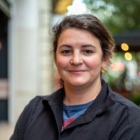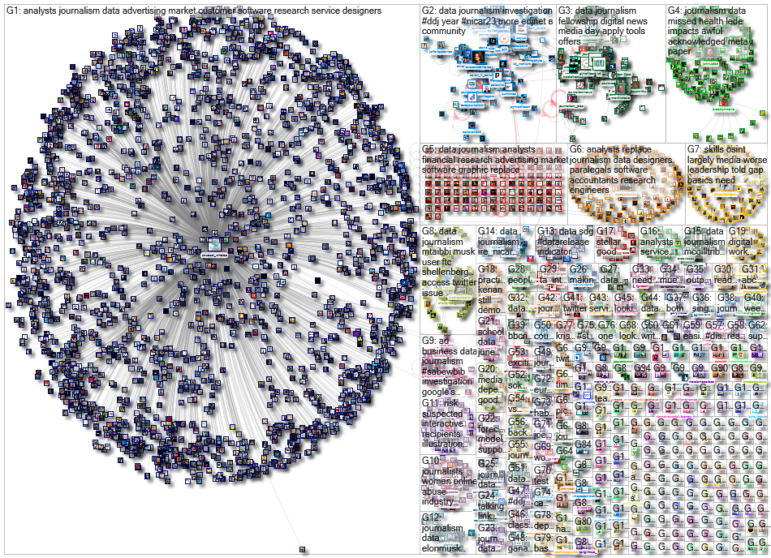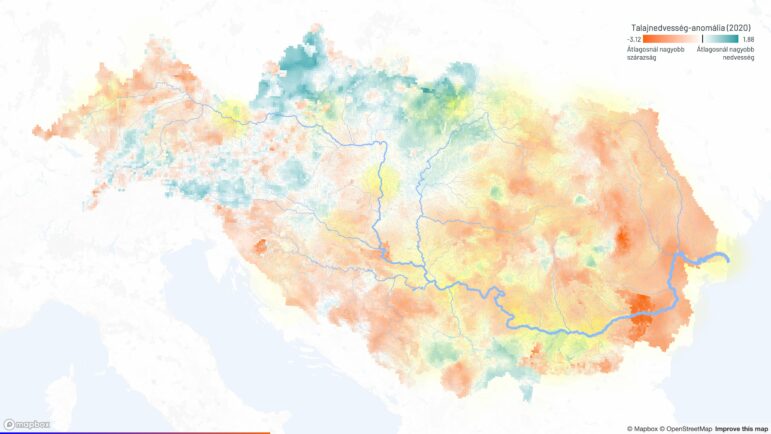

Image: Screenshot, Mapping Diversity
Data Journalism Top 10: Gendered Street Names, Remote Work, Heating the US, Oscars History

Mapping Diversity found just 9% of street names in 30 major European cities that celebrated people were dedicated to women. Image: Screenshot, Mapping Diversity
In the week in which International Women’s Day is celebrated worldwide, data teams across the globe took the opportunity to explore a diversity of issues related to women: whether mapping streets named after women or the distances needed to travel for an abortion in the US, evaluating how safe public spaces are for women or analyzing the increase in the average age of women who get married.
Our weekly NodeXL and human curation of the most popular data journalism stories on Twitter also features a study on remote work in several English-speaking countries, an investigation from Zeit Online of possible solutions to skyrocketing rent in Germany, and an analysis by El País of historical patterns among Oscar winners and how they have been broken.
Measuring Remote Work
A study on remote work at the London School of Economics has mapped a huge amount of data on work trends — with datasets stretching back to 2014 — including more than 250 million online job postings across the US, UK, Canada, Australia, and New Zealand. While the number of people actually working from home peaked in 2021, the share of new job ads explicitly offering hybrid or remote work has “exploded” since the onset of COVID-19. Advertised remote work also shows a substantial divergence across cities — for example, in January 2023 around 30% of job ads in San Francisco offered remote work arrangements, but fewer than 3% of job ads in Miami Beach did. The data is being updated in real-time, and you can download it here.
How the US Heats Its Homes
A team at The Washington Post looked at the great divide in home heating systems in the US. The way Americans heat their homes varies by geography — and the energy source used (electricity, natural gas, propane, or fuel oil) will have profound implications on the ability to shift away from fossil fuels. The split in how homes are heated shows that much of the South, and rural areas, will have an easier time ditching fossil fuels than large cities and coastal areas, because the South, with milder weather, relies more on electricity. In the Northeast, fuel oil still heats many homes. You can look up heating facts for specific cities and neighborhoods here.
Gendered Street Names
The European Data Journalism Network examined 145,933 streets in 30 major European cities across 17 different countries to find out who European street names celebrate. The project, Mapping Diversity, was produced with nine partners, and designed by Italy-based Sheldon Studio. In these cities, only 9% of streets named after people are dedicated to women. Find the project here, and an analysis of the most popular figures in European street names here. Check out the investigation’s methodology here. Also worth a look: A project by Kavya Beheraj, data visualizations editor at Axios, exploring 1,976 named surface features on the planet Venus, including goddesses, heroines, and famous women.
Do More Buildings Stop Rising Rents?
Germany’s government hopes to solve the problem of rising rent by building hundreds of thousands of new developments. A data analysis from Zeit Online — part of a larger series on the development of Germany’s major cities — cast doubt on the claim that building more housing is the solution. After examining statistics from 67 German cities over the past 10 years — including rental costs, population growth, and construction — the report found that even with variations across cities, the one constant is that rent continues to rise regardless: ultimately, there seems to be no statistically significant correlation between building new houses and rental prices.
Analyzing Oscars History
Can anyone predict who will win an Oscar? Historically, some patterns have been repeated: young actresses, white directors, dramatic films. El País analyzed almost 100 years of cinema’s most important award to tell how the winners have only changed in recent decades (and quickly) and how this year’s favorites break with the past. The newspaper also compiled what the betting markets said about this year’s possible winners (spoiler alert: they were confirmed), before last Sunday’s ceremony enshrined the action comedy “Everything Everywhere All at Once” as a runaway success. That film, by itself, broke three Academy Award patterns: It awarded older actresses as well as an Asian co-director — and gave Best Picture to a non-drama.
Mapping Abortion Access
A team at analytics site FiveThirtyEight.com created an interactive map that shows driving distances from US counties to the nearest abortion facility, should more states pass bans or restrictions (which seems likely). Utah, for example, has been an unexpected haven for people in western states seeking to end a pregnancy, but a ban will likely be in place there by next year. According to the map — based on data from an economics professor at Middlebury College —the national average driving distance to an abortion clinic is 87 miles. But a woman living in Cameron County, Texas, would have to drive nearly 830 miles to New Mexico for access.
Reimagining Safe Spaces for Women
In this piece, Kontinentalist, a data-driven storytelling studio based in Singapore, looked at women’s safety when engaging in leisure activities in South and Southeast Asia. Using data collected through a survey, interviews, and research, the outlet showed how patriarchal thinking, misogyny, as well as physical and social barriers undermine the use of public spaces for leisure activities by women, forcing many to turn to online spaces. The team also brings examples of successful initiatives aimed at women’s leisure in cities such as Manila, New Delhi, and Lyari Town (a borough of Karachi), and suggests ways to ensure that these spaces remain “as safe and accessible for women as they are for man.”
Why Women Are Marrying Later
Women in the Brazilian state of São Paulo are marrying later. Or often not even getting married. Data compiled by G1, a Brazilian news portal, show that the average age of women who got married in the region in 2021 was 32.9 years — a 42% increase compared to half a century ago. The phenomenon has several causes, say experts, such as greater higher rates of education, women working longer, and the country’s economic situation. There’s also a red flag: even though education levels in the state are already higher among women, the data show that men in São Paulo still have an average income 26% higher.
Violence in Korean Schools
The success of the series “The Glory,” whose plot revolves around a woman’s vengeance on her high school bullies, has made school violence one of South Korea’s hottest topics. The Mabu News newsletter from SBS, a major Korean broadcaster, uses data to examine the problem — and how South Korea compares to other countries. The report found that 1.7%, or 53,812 students, claimed to have suffered school violence. Mabu News found that the justice system often failed to respond to violent incidents, leading to public – and often anonymous – accusations of bullying and school violence that now play a growing role in South Korean culture. The allegations are no joke: They have derailed the careers of several public figures.
Federal Budget Proposals vs. Reality
Last week, US President Joe Biden unveiled his administration’s detailed annual budget proposal. The text called for tax increases on the super-rich, greater defense spending, and more resources for healthcare. But how closely will his initial plan line up with the actual federal budget that he eventually signs into law? According to a New York Times review of budgets for the last 30 years, not very closely, since both opposition politics and unanticipated major events — like the 9/11 terror attacks, Great Recession, and COVID-19 pandemic — can radically refocus spending. But even if little of Biden’s plan ends up being adopted by Congress, the Times noted how presidential budget proposals remain important documents and indicators of future party policy.
Bonus: Influential Books
Data storytelling luminary Cole Nussbaum Knaflic, author of “Storytelling with Data: A Data Visualization Guide for Business Professionals,” asked her followers which books have been most influential to their careers and why. The resulting thread is a handy reference — including book recommendations and advice — for anybody interested in learning more about data viz, data journalism, or excellent books across many fields.
Thanks again to Marc Smith and Harald Meier of Connected Action for gathering the links and graphing them. GIJN’s Data Journalism Top 10 list is curated weekly.
 Alexa van Sickle is an associate editor at GIJN. She was previously a senior editor for the foreign correspondence magazine Roads and Kingdoms. She has also been an editor at the International Institute for Strategic Studies and a publisher at an international law non-profit in London. She lives in Vienna, Austria.
Alexa van Sickle is an associate editor at GIJN. She was previously a senior editor for the foreign correspondence magazine Roads and Kingdoms. She has also been an editor at the International Institute for Strategic Studies and a publisher at an international law non-profit in London. She lives in Vienna, Austria.
 Ana Beatriz Assam is GIJN’s Portuguese editor and a Brazilian freelance journalist. She worked for the newspaper O Estado de São Paulo as a freelancer, mainly covering stories with data journalism. She has also worked with the Brazilian Association of Investigative Journalism (Abraji) moderating journalism courses.
Ana Beatriz Assam is GIJN’s Portuguese editor and a Brazilian freelance journalist. She worked for the newspaper O Estado de São Paulo as a freelancer, mainly covering stories with data journalism. She has also worked with the Brazilian Association of Investigative Journalism (Abraji) moderating journalism courses.










